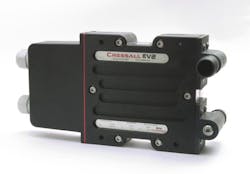Designing Out Safety Risks
It’s been nearly 200 years since Britain’s first railroad was constructed to connect Stockton to Darlington for the transportation of minerals. Since then, rail transportation has evolved at a rapid pace, and now faster, greener, and safer trains travel in larger numbers across the nation every day.
How exactly does technology enhance rail safety? Here, Simone Bruckner, managing director at power resistor manufacturer Cressall, explains the safety mechanisms protecting the UK’s tracks.
The modern British railway still heavily relies on the initial Victorian engineering at the heart of its development, with a few modernizing tweaks along the way. Despite the age of its basic infrastructure, the UK’s rail network is considered one of the safest in Europe, according to the European Union Agency for Railways.
Today, the safety of the railways is ensured through a combination of traditional engineering principles, and new technology.
The Need for Safe Speed
Undeniably, the design and engineering behind trains and the tracks are the most essential factor safeguarding the network.
The Rail Safety and Standards Board (RSSB) has identified overspeeding and lack of effective speed controls as a key risk to passenger and operator safety. Although the instances of overspeeding are decreasing year on year, the number of Train Protection and Warning System (TPWS) activations triggered by overspeeding was still 171 last fiscal year, according to data from the RSSB.
In addition to the risk of overspeeding, as technology advances, trains will continue to get faster and faster. Engineers are constantly developing new designs to enable quicker journeys without compromising on safety or comfort—several trains are now in operation across the globe that travels at over 250 miles per hour (mph).
However, faster trains also bring an increased safety risk that must be mitigated through design. The energy demand involved in decelerating high-speed trains is so large that disk brakes alone are insufficient to guarantee safety. This is why rail typically implements dynamic braking mechanisms in addition to mechanical braking.
Reliable Braking Control
By using an electric motor as a generator to dissipate excess energy, dynamic braking can facilitate regenerative braking. Within the rail industry, this means that when a train decelerates, excess energy is either transmitted through overhead wires for immediate reuse by other trains on the network or is stored onboard using a battery for later use.
Regenerative braking is only a viable option when there are other trains in close proximity, such as on underground lines, or the battery is not fully charged. If neither of these circumstances applies, it may not be possible to use all of the regenerated power.
Removing this excess energy from the system is essential to prevent damage to other components in the power circuit of the train that could lead to complete system failure. A braking resistor is required to safely dissipate excess energy as heat, keeping the train’s power system operational.
Cressall has supplied resistors to the transport sector for over 60 years and remains at the forefront of resistor technology.
The EV2 advanced water-cooled resistor is specifically designed for heavy-duty applications like rail traction. Its unique modular design means up to five modules can be combined to handle up to 125 kilowatts per unit.
Several units can be installed, in parallel or in series, to meet higher power requirements with no upper limit. The unit is proven to meet all major shock and vibration standards required for rail traction applications.
Safeguarding a train’s braking system is an essential mechanism for ensuring rail safety, but traditional engineering is not the only step to keeping our rail systems safe in the modern era—digital tools are also key to reliable rail infrastructure.
Modernizing Old Infrastructure
The British rail system has kept the same infrastructure since its creation in the Victorian era, and some elements are crying out for an upgrade. Although this infrastructure was built to be durable, there is room to improve operational safety through digital tools.
The RSSB accounts for 12% of all train accident risks to infrastructural failures, which are often exacerbated by poor weather conditions such as high winds and heavy rainfall. The risk of derailment and collisions is becoming increasingly rare, but implementing further mechanisms is crucial to achieving optimum safety performance on the tracks.
When considering how train speeds are increasing, relying on human judgment alone is insufficient and unsafe for trains driving at 250 miles per hour and over. Implementing digital tools to assist train operators ensures there is no room for human error, improving safety performance. For example, connected driver advisory systems (C-DAS) optimize a train’s driving style to adhere to the schedule's timing, improving driver guidance and reducing operational incidents.
Rail is easily one of the most efficient ways of traveling across Britain, and will only become more reliable with improvements to operations. Combining old with new enables rail design engineers to combine the benefits of tradition with innovation, for faster, greener, and crucially, safer transportation.

